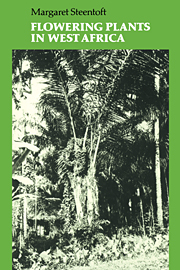Book contents
- Frontmatter
- Contents
- Introduction
- List of symbols and abbreviations
- 1 Species associations
- 2 Vegetation in West Africa
- 3 Annonaceae – soursop family
- 4 Amaranthaceae – amaranth family
- 5 Cucurbitaceae – gourd family
- 6 Ochnaceae – ironwood family
- 7 Combretaceae – afara family
- 8 Guttiferae (Clusiaceae) – butter tree family
- 9 Sterculiaceae – cocoa family
- 10 Bombacaceae – silk cotton family
- 11 Malvaceae – cotton family
- 12 Euphorbiaceae – cassava family
- 13 Caesalpiniaceae – pride of Barbados family
- 14 Mimosaceae – Acacia family
- 15 Papilionaceae – cowpea family
- 16 Ulmaceae – afefe family
- 17 Moraceae – mulberry family
- 18 Meliaceae – mahogany family
- 19 Sapindaceae – akee apple family
- 20 Anacardiaceae – cashew nut family
- 21 Sapotaceae – sheabutternut family
- 22 Apocynaceae – frangipani family
- 23 Asclepiadaceae – blood flower or milkweed family
- 24 Rubiaceae – abura family
- 25 Compositae (Asteraceae) – Tridax family
- 26 Solanaceae – tomato family
- 27 Convolvulaceae – sweet potato family
- 28 Bignoniaceae – jacaranda family
- 29 Acanthaceae – Thunbergia family
- 30 Verbenaceae – teak family
- 31 Labiatae (Lamiaceae) – Hausa potato family
- 32 Commelinaceae – day flower family
- 33 Zingiberaceae – ginger family
- 34 Marantaceae – (West Indian) arrowroot family
- 35 Liliaceae – lily family
- 36 Araceae – cocoyam family
- 37 Palmae (Arecaceae) – palm family
- 38 Orchidaceae – orchid family
- 39 Cyperaceae – sedge family
- 40 Gramineae (Poaceae) – grass family
- General bibliography
- Index of family, generic and common names
22 - Apocynaceae – frangipani family
Published online by Cambridge University Press: 02 November 2009
- Frontmatter
- Contents
- Introduction
- List of symbols and abbreviations
- 1 Species associations
- 2 Vegetation in West Africa
- 3 Annonaceae – soursop family
- 4 Amaranthaceae – amaranth family
- 5 Cucurbitaceae – gourd family
- 6 Ochnaceae – ironwood family
- 7 Combretaceae – afara family
- 8 Guttiferae (Clusiaceae) – butter tree family
- 9 Sterculiaceae – cocoa family
- 10 Bombacaceae – silk cotton family
- 11 Malvaceae – cotton family
- 12 Euphorbiaceae – cassava family
- 13 Caesalpiniaceae – pride of Barbados family
- 14 Mimosaceae – Acacia family
- 15 Papilionaceae – cowpea family
- 16 Ulmaceae – afefe family
- 17 Moraceae – mulberry family
- 18 Meliaceae – mahogany family
- 19 Sapindaceae – akee apple family
- 20 Anacardiaceae – cashew nut family
- 21 Sapotaceae – sheabutternut family
- 22 Apocynaceae – frangipani family
- 23 Asclepiadaceae – blood flower or milkweed family
- 24 Rubiaceae – abura family
- 25 Compositae (Asteraceae) – Tridax family
- 26 Solanaceae – tomato family
- 27 Convolvulaceae – sweet potato family
- 28 Bignoniaceae – jacaranda family
- 29 Acanthaceae – Thunbergia family
- 30 Verbenaceae – teak family
- 31 Labiatae (Lamiaceae) – Hausa potato family
- 32 Commelinaceae – day flower family
- 33 Zingiberaceae – ginger family
- 34 Marantaceae – (West Indian) arrowroot family
- 35 Liliaceae – lily family
- 36 Araceae – cocoyam family
- 37 Palmae (Arecaceae) – palm family
- 38 Orchidaceae – orchid family
- 39 Cyperaceae – sedge family
- 40 Gramineae (Poaceae) – grass family
- General bibliography
- Index of family, generic and common names
Summary
A large family well represented in West Africa, at least half of the genera containing species which are widespread throughout West Africa, many of these, in addition, in Gambia.
Introduced garden species give a useful introduction to the general appearance of members of this family. Allamanda spp., oleander (Nerium oleander), Madagascar periwinkle (Catharanthus roseus), frangipani (Plumeria spp.) and herald's trumpet (Beaumontia grandiflora) are all widely available.
Members of the family may be recognised by their opposite, simple, entire, generally exstipulate leaves (though often with interpetiolar ridges), possession of latex, and cymes of fragrant, gamopetalous 5-part flowers with contorted corolla lobes. The fruit is a berry of two carpels, two berries (of one carpel each), or a pair of follicles (or one by abortion) with plumed seeds. Most of the widespread species are climbers (some with branch tendrils) or under-storey trees in forest, a few only being open woodland savanna species.
Four genera diverge sufficiently from the ‘family pattern’ as to be recognisable on sight. The only species with spirally arranged leaves (and prominent leaf scars) is a fleshy stemmed deciduous shrub, Adenium obesum, found (and often planted) in the northern guinea and sudan zones of Nigeria.
Carissa edulis, in the same zone (Ghana–Nigeria) has branch spines, the only species in the family in West Africa to do so.
- Type
- Chapter
- Information
- Flowering Plants in West Africa , pp. 196 - 204Publisher: Cambridge University PressPrint publication year: 1988



